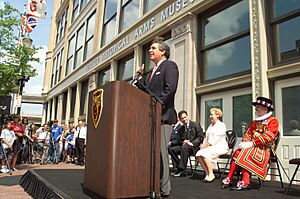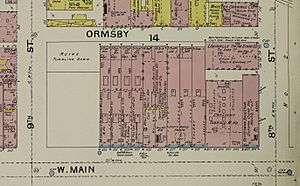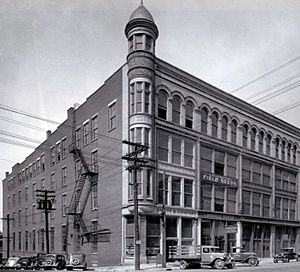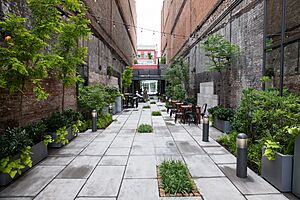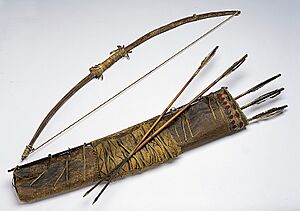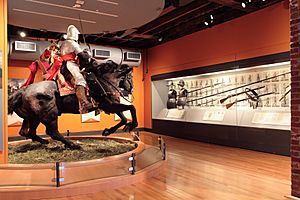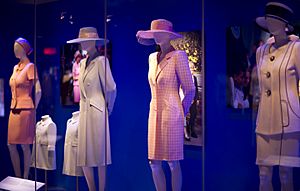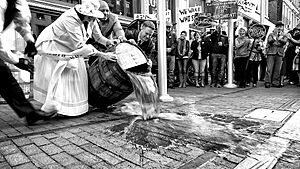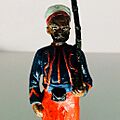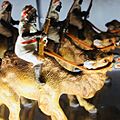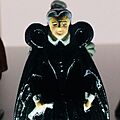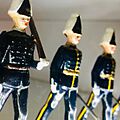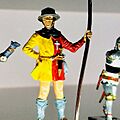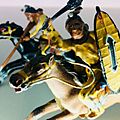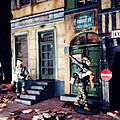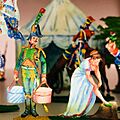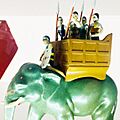Frazier History Museum facts for kids
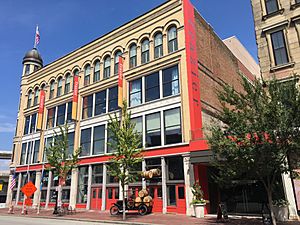 |
|
| Established | May 22, 2004 |
|---|---|
| Location | 829 West Main Street Louisville, Kentucky 40202 |
| Type | History |
| Founder | Owsley Brown Frazier |
| Public transit access | TARC |
The Frazier History Museum is a cool place in Louisville, Kentucky, where you can explore Kentucky's past. It's located on Museum Row in downtown Louisville.
This museum started in 2004, focusing on old weapons and armor. But it has grown a lot since then! Now, it tells the story of Kentucky through amazing objects, special shows, and fun learning programs. It even has bourbon tastings for adults and guided tours.
The Frazier Museum is connected to the famous Smithsonian Institution. It helps everyone learn about Kentucky's history, pop culture, and even its famous bourbon whiskey. You can also learn about the Lewis and Clark Expedition and see a huge collection of tiny historical figures.
In 2018, the museum became the official starting point for the Kentucky Bourbon Trail. This is a popular route for people to visit different bourbon distilleries. The museum is a non-profit, meaning it's funded by donations to keep history alive for everyone.
Contents
Museum History
How the Museum Started
Owsley Brown Frazier was a rich businessman who loved Louisville. In 1974, a big tornado hit his home. A special old Kentucky long rifle that belonged to his family disappeared. He never found it, but looking for it made him love collecting antique weapons.
In 2000, Mr. Frazier showed his weapon collection in an exhibit called The Weapon As Art. About 10,000 people came to see it! This inspired him to open his own museum. He wanted to share his collection with everyone.
In 2001, plans for the Frazier Historical Arms Museum were announced. It would open in a building at 829 West Main Street. The museum's goal was to show the art and skill of weapon making.
In 2003, the Frazier Museum teamed up with the Royal Armouries Museum in England. This museum is very old and used to make armor for English kings. This partnership allowed the Frazier Museum to borrow and display many old weapons and armor from England. It was the first time a British national museum worked so closely with a museum outside its country.
Mr. Frazier paid most of the $32 million needed to build the museum. Construction started in 2001 and finished in 2003.
Frazier Historical Arms Museum Opens
The Frazier Historical Arms Museum first opened its doors on May 22, 2004.
The museum started with about 1,500 items from Owsley Brown Frazier's own collection. These items dated from 1492 to World War I. It also had about 350 items borrowed from the Royal Armouries, dating from 1066 to the 1960s. The collection included guns, cannons, swords, and armor from many countries. There were even life-size figures showing battle scenes from European history.
Frazier International History Museum
On May 17, 2006, the museum changed its name to the Frazier International History Museum. This new name showed that its collection came from many different countries. More foreign weapons and military items arrived from the Royal Armouries that year.
Over time, the museum started to focus less on just war and weapons. It began to explore broader topics of state, national, and global history. The museum also started to feature more large, temporary exhibits instead of just its permanent collection.
In 2010, the Frazier showed the Bloedner Monument. This limestone marker is believed to be the oldest surviving Civil War memorial in the U.S. It honors soldiers who died in the Battle of Rowlett's Station.
Also in 2010, the museum started a fun Halloween tradition called An Evening With Poe. This show featured live performances based on the spooky stories of writer Edgar Allan Poe.
Frazier History Museum Today
In 2011, the museum changed its name one last time to the Frazier History Museum.
In 2012, actor William Shatner (Captain Kirk from Star Trek!) and his wife Elizabeth gave the museum a bronze sculpture. It showed a Japanese warrior on horseback. Later that year, the museum's founder, Owsley Brown Frazier, passed away.
The last items borrowed from the Royal Armouries were returned in 2015.
In 2017, the museum hosted The Hunger Games: The Exhibition. This special show was about the popular movie series. Jennifer Lawrence, a famous actress from Louisville, helped promote the exhibit.
In 2018, the Frazier Museum became a major attraction for people visiting Kentucky's Bourbon Country. On August 30, 2018, the Kentucky Bourbon Trail Welcome Center opened at the museum. This made the Frazier the official starting point of the Kentucky Bourbon Trail.
The An Evening With Poe series ended in November 2019 after ten successful years. The museum's staff had adapted and performed many of Poe's works.
Museum Building
Building Location and History
The museum is in downtown Louisville's Bourbon District. It's in a large building from the late 1800s, originally called the "Doerhoefer Building."
Louisville grew quickly because of river trade after it was settled in 1779. West Main Street became one of the first important streets. The area around Ninth and Main Streets was very busy for business. A tobacco warehouse operated there starting in the 1850s.
On March 27, 1890, a powerful tornado hit Louisville. It destroyed many buildings, including the 9th Street Tobacco Warehouse. Many people worked quickly to rebuild the area. This led to many buildings with cool cast-iron fronts along West Main Street.
In 1897, John Doerhoefer, a tobacco company president, announced he would build new business houses at Ninth and Main Streets. This would be on the site of the old tobacco warehouse.
Building Design
Mr. Doerhoefer hired D. X. Murphy and Bros. to design the new buildings. This firm also designed the famous Twin Spires at Churchill Downs. The Doerhoefer Building was finished in 1898. It was made of brick, stone, and iron, with a tower at the corner.
It's actually a group of four buildings connected together, with one main front. The building has interesting details like pilasters (flat columns) and decorations between the floors.
Ox Breeches Factory
In 1900, a clothing factory called Ox Breeches Manufacturing Company moved into the Doerhoefer complex. It was a big company, making lots of pants and employing about 350 workers.
In 1905, the company made some changes that workers didn't like. They wanted to pay less, work longer hours, and not allow a union. Many workers went on strike. Some even sued the company.
On January 6, 1916, a large fire broke out at the Ox Breeches factory. It caused a lot of damage and completely destroyed one part of the building. You can still see burn marks on some of the wooden beams inside the museum today.
Building Updates
When Mr. Frazier bought the building in 2001, he had much of the inside rebuilt. A new copper-topped dome, called a cupola, was added to the corner of the building. The original one had been removed many years before.
In 2012, the museum expanded its exhibit space. It also bought another building next door. In 2018, a new entrance area and an outdoor park were added.
Museum Layout
Basement
The museum keeps its permanent collection items safely stored in the basement when they are not on display. This area also has offices for staff who work with the collections and exhibits.
First Floor
Outside Areas
In 2018, the Frazier opened the Gateway Garden. This is a public park located next to the museum. It has native Kentucky plants and wooden benches. A staircase leads to a rooftop garden with a balcony overlooking Main Street.
Inside Areas
You can enter the Frazier Museum from Main Street or Washington Street. Both entrances lead to the Cube, a glass entrance area.
Next to the Cube is the Kentucky Bourbon Trail Welcome Center. This is where you buy your tickets. The Museum Store is also nearby, where you can find souvenirs.
The Great Hall is a large open space in the middle of the building with a grand staircase. Around it, you can see parts of The Stewart Collection. This collection features tiny historical figures. The Marshall Charitable Foundation Education Center is a classroom where students can learn history through fun activities.
The north wing of the first floor holds big, temporary exhibits. There's also the Brown-Forman Theater, where actors perform historical events. Smaller exhibits are found in other areas of the Great Hall.
Second Floor
The second floor has The Charles W. Stewart Historic Miniatures Gallery. Here, you can see hundreds of toy soldiers and historical miniatures from The Stewart Collection. These tiny figures show scenes from different wars and historical events.
There's also a champagne parlor with a bar and Victorian furniture. This area also tells the story of the Southern Exposition.
Third Floor
The third floor is home to two main exhibits. The Spirit of Kentucky tells the story of bourbon whiskey. The Lewis and Clark Experience lets you explore the famous journey of Lewis and Clark.
Fourth Floor
The fourth floor has offices for the museum staff. It also has a large, open space with a wooden dance floor and brick walls. This area is used for special events.
Rooftop
The rooftop garden has seasonal flowers and offers great views of the Ohio River.
Museum Collection
The museum's permanent collection has many important historical weapons, war items, and other objects. Most of these were given to the museum by its founder, Owsley Brown Frazier.
Historical Weapons
The museum has very old firearms, like a 16th-century target rifle and a 17th-century crossbow. It also has rifles and handguns from the 1800s made by famous companies like Colt and Winchester.
One of the most famous items is a 1908 rifle that belonged to President Theodore Roosevelt. He used it on a safari in Africa. People call it "The Big Stick" because of his famous saying, "speak softly and carry a big stick."
Other special weapons include Buffalo Bill's rifle, George Armstrong Custer's pistols, and George Washington's hunting rifle. You can also see Geronimo's bow and arrows. Many weapons belonged to soldiers from American or European wars.
Other Historical Items
The museum has a Confederate Flag that might have been carried in the Battle of Seven Pines during the Civil War.
There are also items from American Indian Wars, like beaded clothing.
From Asia and Europe, you can see a battle helmet from medieval Italy and Samurai armor.
Rare documents include the arrest warrant for Mary Todd Lincoln from 1875. You can also see the Boone family bible and an early copy of Uncle Tom's Cabin. There's even a painting of Geronimo by Elbridge Ayer Burbank.
The collection also includes old clothes, dolls, furniture, helmets, jewelry, military uniforms, musical instruments, and toys.
Museum Exhibitions
Permanent Exhibitions
The Founder's Gallery
This exhibit honors Owsley Brown Frazier, the museum's founder. It displays important historical items, weapons, and tools from his collection.
The Spirit of Kentucky
This exhibit is a visual guide to the history and culture of bourbon whiskey. It has three themed rooms. "Enchanted" shows how Kentucky's natural resources help make bourbon. "Gracious" celebrates the people who make bourbon. "Refined" looks at the culture of bourbon drinkers and collectors.
You enter through a covered bridge and leave through the Bottle Hall. This hall will eventually show every brand of bourbon made in Kentucky.
The Stewart Collection
Old Toy Soldier magazine says The Charles W. Stewart Historic Miniatures Collection is "one of the finest collections of rare historic toy soldiers on permanent public display in the world today." It started in 2011 and has grown a lot. By 2019, it had about 30,000 tiny figures, vehicles, and accessories. Over 10,000 of these are on display.
The tiny scenes in the collection show battles from many different wars. These include the American Revolution, the Napoleonic Wars, the American Civil War, and World War I and World War II.
The Lewis and Clark Experience
This exhibit makes you feel like you're on the Lewis and Clark Expedition. This famous journey from 1804 to 1806 explored the lands of the Louisiana Purchase. The explorers gathered information about plants, animals, and the land.
Special Exhibitions
Southern Exposition
A fancy room on the second floor is used for events. It also has an exhibit about the Southern Exposition. This was a big annual event in Louisville, like a mini World's Fair, from 1883 to 1887.
West of Ninth: Race, Reckoning, & Reconciliation
This exhibit looks at the history of racial inequality and segregation in Louisville. It focuses on the area west of Ninth Street, known as the West End, which is linked to the African-American community. The exhibit explores how these historical issues have led to ongoing discussions about race in Louisville.
The exhibit includes items found during digs in the historic Black neighborhood of Beecher Terrace. It also features objects related to Black history in Louisville and recent protests.
Past Exhibitions
- British Royal Armouries USA, 2004 – 2015. This show featured over 300 European items borrowed from the Royal Armouries Museum. It included old guns, swords, and armor, plus life-size figures showing battle scenes.
- Water Works, 2010 – 2011. This exhibit told the story of the Louisville Water Company. It showed how Louisville went from having unsafe water to winning "Best Tasting Tap Water in America."
- Da Vinci: The Genius, 2011. This traveling exhibit celebrated Leonardo da Vinci. It featured full-size models of his inventions, like a glider, a helicopter, and a parachute.
- Samurai, 2012. This exhibit explored the art and ideas of the military leaders of medieval Japan. It included armor, weapons, and other items from Samurai culture.
- Diana: A Celebration, 2012 – 2013. This show looked back at the life of Diana, Princess of Wales. It featured over 150 of her belongings, including her royal wedding dress and designer outfits.
- Spirits of the Passage: The Story of the Transatlantic Slave Trade, 2013. This exhibit displayed nearly 150 items found from the Henrietta Marie, an English slave ship that sank in 1700.
- Mythic Creatures, 2013. This exhibit explored the origins of mythical creatures like dragons, mermaids, and unicorns. It featured fossils, paintings, and other cultural items.
- Spirits of the Bluegrass: Prohibition and Kentucky, 2015 – 2018. This exhibit explored the time of Prohibition, when alcohol was illegal. It showed the rise of bootleggers and speakeasies.
- The Hunger Games: The Exhibition, 2017. This exhibit explored the movie series The Hunger Games. It featured recreated sets, props, and costumes, like Katniss's bow.
- Magnificent Mona Bismarck, 2018. This show looked at 1930s style icon Mona Bismarck. It featured clothes, hats, shoes, and jewelry from famous designers.
Images for kids
See also


